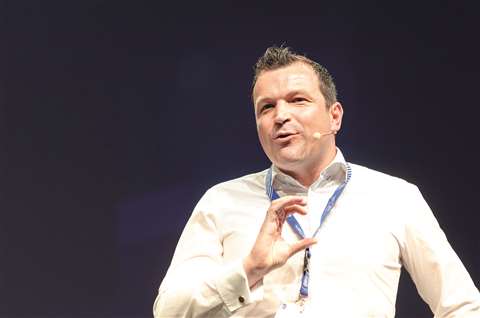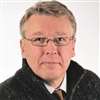Roll-Royce’s journey to net zero
07 December 2022
Rolls-Royce Power Systems looks to offer a complete portfolio of power generation options
 mtu Series 4000 H2-ready gas engine at the Power Gen Symposium 2022. (Photo: Rolls-Royce)
mtu Series 4000 H2-ready gas engine at the Power Gen Symposium 2022. (Photo: Rolls-Royce)
In June this year, Rolls-Royce Power Systems held its mtu Power Generation Symposium 2022 at the company headquarters in Friedrichshafen, Germany. Under the headline “Journey to Net Zero”, the event showcased the new technology Rolls-Royce Power Systems has recently brought to market, while also introducing new areas of investigation for sustainable power generation.
“It was interesting to take a step back and see where we had come from when we last had the event in 2019,” says Andreas Görtz, president, Sustainable Power Solutions, in an interview with Diesel Progress International. “[At that event] we only had two products – a diesel and a gas generator set. We only had plans in place for a battery system. Now, we have a different portfolio, we can offer diesel, gas, battery, hydrogen engines, fuel cell and electrolyzers. It was a chance for our partners and customers to see the journey we’re on and what we had achieved.”
 Andreas Görtz, president, Sustainable Power Solutions, Rolls-Royce Power Systems.
Andreas Görtz, president, Sustainable Power Solutions, Rolls-Royce Power Systems.
Also in June, Rolls-Royce announced that it had acquired a 54% majority stake in Hoeller Electrolyzer (full financial details were not disclosed). Based in Wismar, the company’s polymer electrolyte membrane (PEM) stacks will now go on to form the basis of a new “Prometheus” product range in the Power Systems division. The name is appropriate; in Greek mythology, Prometheus stole fire from the gods and gave it to humanity, thus fostering the first civilization.
Following the investment announcement, Dr. Otto Preiss, COO and chief technology officer at Rolls-Royce Power Systems, said, “We are methodically growing our hydrogen portfolio and securing access to this fascinating technology. This will enable us to supply complete hydrogen solutions and make a significant contribution to protecting the climate.”
In essence, the hydrogen produced acts as an energy storage system for use as and when required.
Complete H2 solution
“[The Hoeller] stack technology is part of our IP. We will build our first electrolyzer around this core tech, with a first demonstrator up and running by the middle of 2023,” explained Görtz. A first customer project is planned for 2024.
The PEMs based on the technology from Hoeller can be combined with fuel cell modules delivered from Cellcentric, a joint venture between Daimler Truck, Volvo Group and other companies. Forming the basis of future mass market fuel cell applications, each cell will have a net power output of about 150 kW. Daisy-chained together, the systems will be capable of producing several megawatts of green hydrogen, suitable for delivering zero-emissions backup power for applications including large data centers, or to provide power to the grid if renewables are unavailable.
“Electrical generators based on fuel cells represent the next leap forward in the energy transition, both for us and our customers,” said Andreas Schell, CEO of Rolls-Royce Power Systems, in a statement covering the formation of Cellcentric in late 2021. Perry Kuiper, head of sales, Sustainable Power Solutions, added, “We’ve declared it our mission to have over half of the data centers supplied by emergency power from fuel cells in the future.”
The Hoeller stack technology and fuel cells from Cellcentric will enable Rolls-Royce Power Systems to deliver a complete hydrogen power generation solution. “We will pair up the electrolyzers and the fuel cells, which will be connected to battery packs and control management systems,” says Görtz. With the inverters, we will have everything in place to provide electrical energy to a customer or to a grid.”
Hedging bets
Görtz says that three fuel cell systems are planned for delivery to the Enerport II program. Located at Duisport, Europe’s largest inland port, the cells will serve as part of a hydrogen-based supply network including conversion and storage systems (see box below for more).
“These fuel cell systems can develop 500 kW each,” Görtz outlined. “They will be delivered in 2023, our first units in the field. We’re also continuing to test the technology with a series of selected customers. From 2025, we’re planning to have the electrolyzer and fuel cell as a standard product.”
Asked if the focus on hydrogen fuel cells is a hedge against customers possibly moving away from diesel, Tobias Ostermaier, president, Stationary Power Solutions, states that the goal is simply to have the most complete product portfolio.
 Tobias Ostermaier, president, Stationary Power Solutions, Rolls-Royce Power Systems.
Tobias Ostermaier, president, Stationary Power Solutions, Rolls-Royce Power Systems.
“At the symposium, our customers said that we have one of the widest product portfolios in the market, competitive diesel, gaseous and other system types. In addition, over the last three years we’ve added new systems which use sustainable technology. That’s why the announcement about electrolyzers was so important, as it was the last part of the puzzle.”
Continuing, Ostermaier pointed out that while hydrogen solutions are still a future technology (if only one or two years), Rolls-Royce Power Systems has made strides to make traditional technologies more sustainable. “Our Series 4000 and Series 1600 diesel power generation systems are now compatible with HVO (hydrotreated vegetable oil) and other sustainable fuels, including PtX and BtL. That’s with any D rating. That means any of the existing power generation fleet, more than 80,000 engines, could in theory and practice be operated using sustainable fuel. That would have an immediate impact on the CO2 footprint.”
Ostermaier says Rolls-Royce Power Systems is committed to investing in further research into diesel, supporting the “traditional” business sector while also developing future technologies. Case in point, a gen-set using HVO can deliver CO2 emission reductions of up 90%, while aftertreatment can significantly reduce NOx output. Future developments covering internal combustion engines (ICEs), such as the mixing of gas with hydrogen, have the potential to cut CO2 emissions still further – that’s before the introduction of ICEs using 100% hydrogen.
Of course, such emissions reduction as those outlined by using HVO are only possible if the HVO fuel is available. In response, he observes that HVO is more widely available than hydrogen and can rely on the same infrastructure as diesel.
“In the end, our customers will make their choices. We have to offer what is best for [customer] needs, diesel, gas, or H2. We have to be prepared for anything,” he says.
Market growth
Rolls-Royce Power Systems has always been a worldwide player in “mission-critical” applications, including hospitals, data centers and airports. But Ostermaier says that in addition to these, delivery of gen-sets for smaller, decentralized continuous power generation solutions is a growth area.
Görtz is in agreement: “A lot of customers in Pakistan are buying CHP continuous power units. We just finished a huge project in Chile, five sites, 500 MW, to provide stability to the grid. So, besides data, hospitals, airports, we have a lot customers either directly or indirectly delivering power to remote villages.”
 Photo: Rolls-Royce Power Systems
Photo: Rolls-Royce Power Systems
Even in countries such as the UK, gen-sets are used for grid stabilization, or possibly as a substitute for a lack of grid capacity. Görtz noted, “For example, a company might be looking to build a new data center and National Grid will say ‘come back in X number of years; we can’t provide the power now.’ In cases like this, customers are obliged to supply their own power; they have to invest in decentralized power from Day 1. That’s one of our sweet spots.”
Particularly in remote locations, the gen-set of choice will still be powered by diesel. While such fuels as HVO might be too expensive, or simply unavailable, there are now microgrid solutions designed to cut emissions from off-grid power generation. For customers in appropriate global locations, a diesel/battery hybrid could be the solution of choice. This uses photovoltaic panels to charge batteries during the day and that 100% renewable power is only “topped up” by diesel.
“Fueled by renewables and using a clever automation system, you use as much renewable as possible, store energy in the batteries and use diesel in an emergency,” says Ostermaier.
Inevitably, even this type of technology will cost more than a standard diesel-powered gen-set. But while Rolls-Royce Power Systems has placed a high priority on achieving net zero, the company is convinced that customers are also interested in finding ways to achieving their own CO2-reducing goals.
 Planned ramp-up of H2 blending in mtu engines. Photo: Rolls-Royce Power Systems
Planned ramp-up of H2 blending in mtu engines. Photo: Rolls-Royce Power Systems
“You always have the first movers, new adopters,” says Görtz. “But we believe fuel cell tech will soon be a mass market product, especially when it becomes more commonplace in transportation. This will see costs significantly reduced. The ban on passenger car ICEs from 2035 will also see the price for engine parts go way up, as volumes come down. This is happening as the volume of fuel cells goes up. There will be a crossover point, I don’t know exactly when, where the new tech is more affordable than the old tech.”
Essentially, the view is that Rolls-Royce Power Systems has a social responsibility to help move the world on to more sustainable power generation methods. Yet, at the same time, the company still has a responsibility to simply deliver power, keeping things up and running. As Görtz puts forward, stopping delivery of diesel power generation systems wouldn’t help society in any way.
But installing sustainable solutions in remote areas is not the only concern, as Ostermaier explained. “Perhaps you have a company looking to secure funds. With perceptions the way they are, that has to be done with companies which have a green outlook. If you want investment for a new data center, you need to convince the investor that you’re on the green path or they won’t buy in.”
In the end, Rolls-Royce Power Systems can only put forward solutions which generate power in ways that are the least damaging to the environment. Ultimately, customers and the wider market will decide which will be the prevailing technology from each of the provided alternatives.
 Hydrogen as an energy solution for inland ports. Photo: Rolls-Royce Power Systems
Hydrogen as an energy solution for inland ports. Photo: Rolls-Royce Power Systems
Rolls-Royce Power Systems is in the process of delivering three fuel cell systems to the Enerport II program at Duisport, the largest inland port in Europe. A further two hydrogen internal combustion engines will also be delivered, with the combined technology creating a hydrogen-based energy supply network.
The mtu fuel cell systems are intended to deliver power as soon as the public power grid reaches its limits, possibly when there is a maximum number of ships docked in port. The two H2 ICEs, based on CS Series 4000 engines, will convert hydrogen into electricity, either for delivery directly to the container terminal or to the grid. Waste heat will be captured to heat facility buildings.
The installation will be further supported by an array of photovoltaic panels and connected storage batteries integrated into the local power supply network.
Described as “decentralized and climate friendly,” Enerport II is put forward as a blueprint of what future power generation could look like, with fuel cells, ICEs and solar all contributing to reduce related CO2 emissions.




